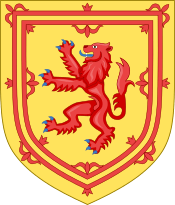Udal law
Udal law is a Norse derived legal system, which is found in Shetland and Orkney in Scotland and in Manx law[1] in the Isle of Man. It is closely related to Odelsrett.
History
Udal law was codified by the Norwegian kings Magnus I and Magnus VI. The Treaty of Perth transferred the Outer Hebrides and Isle of Man to Scots law while Norse law and rule still applied for Shetland and Orkney.
Scottish Courts have intermittently acknowledged the supremacy of udal law in property cases up to the present day. Major differences from Scots law include shore ownership rights, important for pipelines and buried cables.
Udal law generally holds sway in Shetland and Orkney, along with Scots law.
Description
Not all land in Shetland and Orkney can be described as falling under udal tenure. The type of tenure depends on how the title arose:[2]
- Unwritten udal title, while rare, does exist, as udal law did not require written title deeds.
- Recorded udal titles, as entered in the Sasine Register, provides proof by prescription for the purposes of the Prescription and Limitation (Scotland) Act 1973.[3]
- Some udal proprietors resigned their lands to the Crown in exchange for a grant of feudal title to the dominium utile, thus removing the land from udal law.
- Where some feu dispositions arose in quasi-feudal circumstances, such as sales under the right to buy legislation with respect to council houses, the terms of the relevant deed will govern which tenure applies.
The udal tenant held without charter by uninterrupted possession on payment to the Crown, the kirk, or a grantee from the Crown of a tribute called skat (Norwegian: skatt, now meaning "tax"; cognate to the English term scot, which referred to a similar payment), or without such payment, the latter right being more strictly the udal right. They were convertible into feus at the option of the udallers.[4] Succession law had unique traits, as the eldest son inherited the father's main residence, while the rest of the property was shared among siblings, daughters inheriting half as much as sons.[5]
There are several significant aspects on udal law that are not seen elsewhere in the UK:
- While in the rest of Britain ownership of land extends only to the high water mark (where the Crown is deemed to own what lies below it), in Orkney and Shetland it extends to the lowest astronomical tide.[6][7] This caused complications during the development of the North Sea oilfields, as builders of pipelines needed permission from the foreshore owners in order to proceed with their work.[8] Under the Land Registration etc. (Scotland) Act 2012,[9] entry of title onto the Land Register of Scotland must include a cadastral plan,[10] but the foreshore on such plans needs only to be drawn at the mean low water mark of ordinary spring tides.[11] Where udal title exists, an appropriate note must be inserted on the plan to indicate that title extends to the lowest ebb.[11]
- Swans, which are the property of the Crown elsewhere in the UK, are the property of the people in Orkney and Shetland.[12]
Modern land reform
The Abolition of Feudal Tenure etc. (Scotland) Act 2000 extinguished any remaining obligations to pay skat, effective 28 November 2004.[2] In addition, the Land Registration (Scotland) Act 1979 (as amended by the Title Conditions (Scotland) Act 2003) provides that, as of 1 April 2003, first registration will be required on any transfer of an interest in udal tenure that had not previously been entered in the Land Register, as real rights can only be obtained by registration.[2]
See also
Further reading
- Drever, W.P. (1900). Udal Law in the Orkneys and Zetland. Edinburgh: William Green & Sons.
- Drever, W.P. (1904). "Udal Law and the Foreshore". The Juridical Review. 16: 189. (subscription required)
- Jones, Michael R.H. (1996). "Perceptions of Udal Law in Orkney and Shetland" (PDF). Shetland's Northern Links: Language & History. Edinburgh: Scottish Society for Northern Studies. pp. 186–204. ISBN 0-95059949-2.
- Linklater, Eileen (2002). Udal Law - Past, Present and Future? (PDF) (LLB (Hons)). University of Strathclyde.
- Ryder, Jane (1988). "Udal Law: An Introduction" (PDF). Northern Studies. Edinburgh: Scottish Society for Northern Studies. 25: 1–20.
- Lord Advocate v University of Aberdeen & Budge [1963] CSIH 1, 1963 SC 533, 1963 SLT 361 (2 August 1963)
References
- ↑ Collegium Medievale 8.1 (1995, publ. 1996), 5-49 Archived 2007-06-23 at the Wayback Machine.
- 1 2 3 "Legal Manual - L32: Udal Tenure". Registers of Scotland. 21 July 2015.
- ↑ UK Parliament. Prescription and Limitation (Scotland) Act 1973 as amended (see also enacted form), from legislation.gov.uk.
- ↑

- ↑ "Udal law". charles-tait.co.uk. 2002. Archived from the original on 10 February 2006.
- ↑ "Wake Up Scotland!". udallaw.com. Shetland & Orkney Udal Law Group.
- ↑ "Research Summary: Udal law and coastal property ownership" (PDF). University of Dundee. 2002. Archived from the original on 2005-02-24.
- ↑ "Norse landing". The Scotsman. 22 February 2003.
- ↑ Land Registration etc. (Scotland) Act 2012, 2012 asp 5
- ↑ "The cadastral map—the land register and land covered by water" (PDF). Registers of Scotland. 17 June 2016.
- 1 2 "Udal Law and the Foreshore in Orkney & Shetland". Registers of Scotland. 13 March 2017.
- ↑ "Sir Peter's taste for swan has him fall foul of law". The Scotsman. 19 March 2005.
External links
- Anderson, Richard N.M. (2001). "What is the future for udal law?". orcadian.co.uk. Orcadian News Archives. Archived from the original on 14 June 2011.
